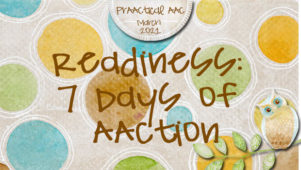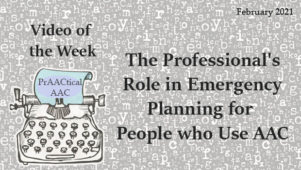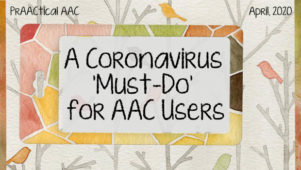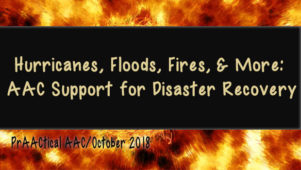Emergency Preparedness for the AAC Family
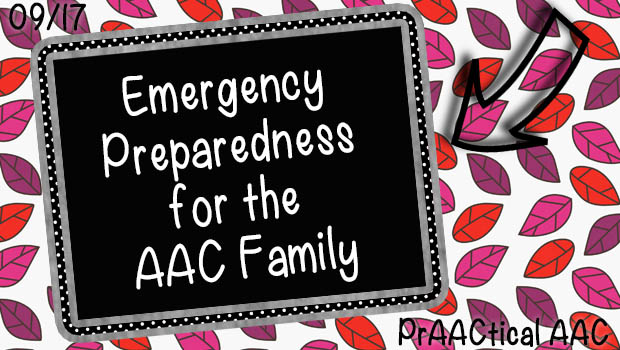
Many of us live in areas prone to storms or other game-changing weather events, but even those who don’t should prepare for emergency situations. Today, as we continue our preparations for Hurricane Irma, one of the strongest storms ever recorded in the open Atlantic, my friend, Amy Goldman, takes the reins. With her broad background in AAC and AT and her incredible advocacy work, we are in no better hands.
If you’re inclined toward prayers or even if you’re not, we here in South Florida could use any positive energy you can send our way. Stay safe, friends, and remember to take care of those around you.
:::::::::::::::::::::::::::::::::::::::::::::::::::::::
With the images of the devastation of Hurricane Harvey in front of us, and with Irma and possibly Jose in the forecast, it is actually a little late to be talking about emergency preparedness. However, it is good to reflect on some of the actions that users of AAC, people who support individuals who rely on AAC, and their families should consider taking in order to be prepared. There are many resources available to help 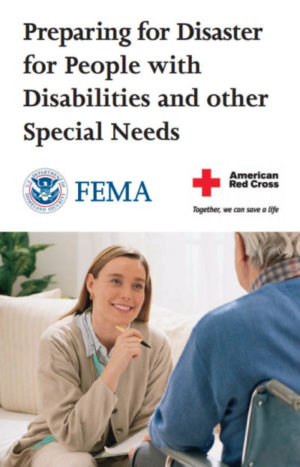 people with disabilities develop a personal emergency preparedness plan (e.g., https://www.fema.gov/media-library-data/20130726-1445-20490-6732/fema_476.pdf). Being prepared is a good topic to address in transition planning, as personal preparedness is an “adult” responsibility for us all!
people with disabilities develop a personal emergency preparedness plan (e.g., https://www.fema.gov/media-library-data/20130726-1445-20490-6732/fema_476.pdf). Being prepared is a good topic to address in transition planning, as personal preparedness is an “adult” responsibility for us all!
This blog includes some considerations that may be unique to people who use AAC.
General tips:
- Register your device and any software. This can help prove your ownership of the device if replacement is needed.
- Keep warranty/insurance information and device serial numbers with your important papers, in case the device is damaged in the emergency/disaster. It’s a good idea to have copies of those papers with a friend or family member who lives some distance from you (and wouldn’t be affected by the emergency or disaster affecting YOU!).
- If you are using an “app” and the tablet/smartphone is lost, you may be able to “re-load” it on another device from the app store, at no cost.
Think about how you would communicate with emergency personnel:
- If you mostly use a speech generating device, do you have a non-electronic back-up system (e.g. alphabet board; communication book)?
- Do you have vocabulary available in your system that you will want to discuss needs, feelings, special health considerations and other issues that may arise, especially if you are communicating with unfamiliar people (first responders, shelter staff)? This may include pre-programmed words, individual icons or icon sequences. Make sure you understand the meaning of the words.
- Include pre-programmed messages or a pre-printed, laminated page that explains how you communicate.
- Even if you usually spell most of your messages, the stress of the emergency or disaster may make spelling more difficult or time-consuming.
- Is your vocabulary routinely “backed up” (e.g. back-up of SGD software/apps; electronic versions or PDF copies of lite tech boards/systems) on the cloud or other electronic storage that can be remotely retrieved (NOT just on a thumb drive)?
Evacuation: Leaving your home
- Plan for the possible need to evacuate (leave) your home.
- Put together a “go kit” or go-bag, a duffle bag or suitcase you can easily grab if you have very short notice. There are many resources to learn what should go in your kit!
- Make a list of the assistive technology devices you use, including what you use for communicating, eating, getting dressed, etc. Put essential ones in your kit! Think about getting spare ones to keep in the go-bag so you won’t be hunting around in the emergency. For example, if you have an older version of your speech generating device that still works, charge it routinely and keep it in your go-bag.
- Your AAC system(s) and components should be tagged (ideally with a laminated or waterproof label) in case it gets lost or separated from you.
- Take a picture of yourself using your speech generating device, especially if requires special positioning or mounting. This will also establish your ownership of the device.
- When you leave, remember to take your devices and chargers.
- HOW will you leave? It is especially important to think about this step if you need a special vehicle like a lift-equipped van.
- LEAVE whenever an evacuation is recommended. Authorities might recommend people with disabilities leave earlier than others.
Shelter in Place: Staying put
- You may need to stay where you are, for as long as five – seven days.
- You may be without electricity. It is a good practice to always have your device fully charged – and/or a fully charged, portable storage power bank.
- Have a back-up system available if you cannot use your speech-generating device.
:::::::::::::::::::::::::::::::::::::::::::
Use the slider on the right side of the image below to explore social narratives and other storm-related resources.
Filed under: Featured Posts, PrAACtical Thinking
Tagged With: emergency preparedness, storm
This post was written by Carole Zangari

